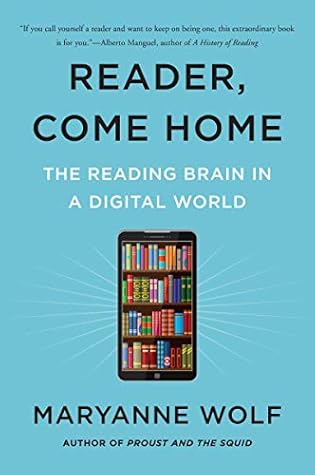More on this book
Community
Kindle Notes & Highlights
Read between
May 19 - July 23, 2021
In the seven years it had taken me to describe how the brain had learned to read over its close to six-thousand-year history, our entire literacy-based culture had begun its transformation into a very different, digitally based culture.
a Chinese, character-based reading-brain6 circuit has both similarities to and discernible differences from an alphabet-reading brain.
There are many things that would be lost if we slowly lose the cognitive patience to immerse ourselves in the worlds created by books and the lives and feelings of the “friends” who inhabit them.
movies and film can do some of this, too, there is a difference in the quality of immersion that is made possible by entering the articulated thoughts of others.
Reading at the deepest levels may provide one part of the antidote to the noted trend away from empathy.
when we read a piece of fiction “closely,” we activate regions of the brain that are aligned to what the characters are both feeling and doing.
In one of the most famous statements about scientific breakthroughs, Louis Pasteur wrote, “Chance comes only to the prepared mind.”45 That elegant statement could just as easily describe the role of background knowledge in the deep-reading brain.
the basic neurological principle—“Use it or lose it”—is
Edmundson articulates here two connected, insufficiently discussed threats to critical thinking. The first threat comes when any powerful framework for understanding our world (such as a political or religious view) becomes so impenetrable to change
The second threat that Edmundson observes is the total absence of any developed personal belief system in many of our young people,
For them, education is knowing and lordly spectatorship, never the Socratic dialogue about how one ought to live one’s life.
the last thing a society needs is what Socrates feared: young people thinking they know the truth before they ever begin the arduous practice of searching for it.
the average attention span of adults was determined to be a little over five minutes. Although five minutes may seem rather unimpressive,37 more noteworthy is that it is barely half of what it was only a decade earlier.
we must work to protect and preserve the rich, expansive, unflattened uses of language.
When nurtured, human language provides the most perfect vehicle for the creation of uncircumscribed, never-before-imagined thoughts, which in turn provide the basis for advances in our collective intelligence. The converse is also true, with insidious implications for every one of us.
Separating truth from fiction takes time, information literacy, and an open mind, all of which seem in short supply in a distracted, polarized culture. We love to share instantly—and that makes us easy to manipulate.
Certainly Socrates never had time to understand the potential value of having both internal and external sources of memory, but we do.
In Socrates time it would have meant a great increase in reliance on slaves to cultivate exfernal memory. This could be an interesting lens through which to look at its disadvantages today.
There is a very simple, very beautiful Native American story I have always remembered. In this story a grandfather is telling his young grandson about life. He tells the little boy that in every person there are two wolves, who live in one’s breast and who are always at war with each other. The first wolf is very aggressive and full of violence and hate toward the world. The second wolf is peaceful and full of light and love. The little boy anxiously asks his grandfather which wolf wins. The grandfather replies, “The one you feed.”
Hesse wrote in a little-known essay called “The Magic of the Book”: Among the many worlds which man did not receive67 as a gift of nature, but which he created with his own spirit, the world of books is the greatest.
multiplying distractions within the enhanced e-books often as not impeded comprehension:
there may be an incremental diminishment of the use of working memory for children due to what they perceive as the impossibility of trying to remember all the information typically presented on a screen that often moves on.
early brain development gives prominence to the networks underlying feeling, even before cognition.
One of the most salient influences on young children’s attention involves the shared gaze that occurs and develops while parents read to them.
there is worrisome evidence that over the last ten years parents have begun to read less to their children.
the radius of children’s activity has shrunk by 90 percent since 1970.
The fourth grade represents a Maginot Line between learning to read and learning to use reading to think and learn.
we are now on the threshold of being able to predict highly specific reading trajectories of young children before they ever begin to read.
Stories are one of humanity’s most powerful vehicles for making lasting connections to people we will never meet.
In the first quarter of our century we daily conflate information with knowledge and knowledge with wisdom—with the resulting diminution of all three.
Twenty years ago Martha Nussbaum wrote about the susceptibility and the decision making of citizens who have ceded their thinking to others: It would be catastrophic to become a nation22 of technically competent people who have lost the ability to think critically, to examine themselves, and to respect the humanity and diversity of others.
In a dialogue between Umberto Eco and Cardinal Carlo Maria Martini, the cardinal reiterated a timeless view of the democratic process that is pertinent to this conclusion: “The delicate game of democracy provides24 for a dialectic of opinions and beliefs in the hope that such exchange will expand the collective moral conscience that is the basis of orderly cohabitation.”


